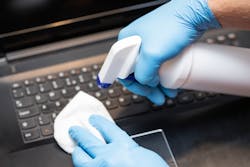Cleaning and maintaining classrooms and other school spaces is a fundamental responsibility for education institutions at all times, but the importance of these tasks has become heightened in the months since the spread of the Covid-19 virus emptied school buildings and disrupted student learning.
Taking the necessary steps to sanitize and disinfect school facilities is critical in making it possible for students and teachers to feel confident that they can return to classrooms safely and resume in-person instruction.
“No one wants to return to in-person learning more than the educators who have dedicated their lives to helping their students succeed, but reopening school buildings must be done safely and equitably,” says Becky Pringle, president of the National Education Association.
It remains to be seen whether administrators, teachers, custodians and parents can come to a consensus about the sufficiency of the health and safety precautions that schools have put into place. Parents of many students feel online instruction is inferior to in-person classes and their children are falling behind; but many teachers say that the risks to their health of returning to classrooms that do not have adequate safety protocols in place are too great.
Many state and federal agencies and other organizations have put together recommendations to help schools provide the needed levels of cleaning and disinfection to combat the coronavirus.
Guidance from the Centers for Disease Control and Prevention (CDC) states that before disinfection, visibly dirty surfaces should be cleaned with soap and water.
Frequently touched surfaces (e.g., tables, doorknobs, light switches, desks, keyboards, faucets) should be cleaned and disinfected more often. Areas unoccupied for seven or more days need only routine cleaning, the CDC says.
To disinfect, schools should use a disinfectant approved by the Environmental Protection Agency for use against Covid-19.
The CDC emphasizes the importance of adhering to a chemical disinfectant’s application and safety instructions. To safely use such disinfectants, workers should wear gloves, and consider wearing safety glasses or goggles. The area being disinfected should have adequate ventilation, and custodians should be vigilant about using only the recommended amounts.
For soft surfaces, custodians should clean them using soap and water, or cleaners appropriate for use on such surfaces. If possible, soft surfaces should be laundered in the warmest appropriate water setting and dried completely.
To aid the cleaning of computer screens or other electronics, consider placing a wipeable cover on the device.
All custodians and any other staff members who clean and disinfect a school site should have access to proper personal protective equipment, including gloves, eye protection, and respiratory protection, the CDC says.
If respiratory protection is recommended on a product’s safety data sheet, consider using a respirator with a combination cartridge for chemicals and particulate exposure.
Workers should discard disposable gloves after each cleaning. For reusable gloves, dedicate a pair for only disinfecting surfaces. After removing gloves, workers need to wash their hands with soap and water for at least 20 seconds.
The National Council on School Facilities has compiled a detailed list to guide schools as they try to reopen schools while protecting public health. The list makes it clear that reopening schools will require increased efforts for custodians, teachers and administrators.
Among the steps pertaining to cleaning and disinfecting: schools should purchase adequate amounts of disinfectants, sprayers, hand sanitizers and vacuum cleaners with HEPA filters, as well as the personal protective equipment or other protections that custodians need to carry out their responsibilities.
Schools also should estimate the added time needed to meet a higher standard of living and should hire and train additional custodians to handle the increased level of work required. Teachers, before they leave for the day, should wipe down surfaces they have touched with disinfectant wipes, and custodians should clean each room after the staff leaves.
Administrators also should develop a plan for making sure school buses are cleaned after each route, the council recommends.
Sidebar: Reopening Debate
As the deadly spread of Covid-19 continues into 2021, the tension has been growing between those eager to have students return to in-person instruction and those who don’t believe classrooms and other school facilities have been made safe enough to protect the health of students and staff from the virus.
Advocates of reopening classschoorooms express concerns that students in online or hybrid settings are falling behind academically and may struggle mentally and emotionally because of prolonged isolation and separation from classmates. Those opposed to the widespread resumption of in-person classes say some school facilities are being cleaned and sanitized sufficiently to minimize the chances that students and staff will contract Covid-19.
The clash over reopening has been especially antagonistic in Chicago, where the teachers union has been opposing the district’s efforts to reopen many of its classrooms.
The Chicago school system says it has spent $8.5 milllon to place a HEPA purifier in every classroom and front office. The devices filter more than 99.99% of airborne viruses, bacteria, and mold, the district says.
It has hired 400 additional custodians, spent more than $3.5 million to place 50,000 hand sanitizers in high-traffic areas and additional soap dispensers for more frequent hand washing.
Chicago schools also have spent more than $2 million for 86,000 containers of disinfectant wipes for classrooms and other high-touch areas.
Every district school now has a hospital-grade mister spray that evenly applies disinfectant.
Some preschool and special education students returned to classrooms in January, but the Chicago Teachers Union, which represents more than 25,000 employees of the district, asserts that a more widespread return to in-person instruction is premature while Covid-19 continues to spread.
The union also contends that some of the teachers and staff who have returned to classrooms report safety deficiencies, such as no heat, shortages of personal protective equipment and cleaning supplies, and inadequate or no portable HEPA filters in their classrooms.
About the Author
Mike Kennedy
Senior Editor
Mike Kennedy, senior editor, has written for AS&U on a wide range of educational issues since 1999.
